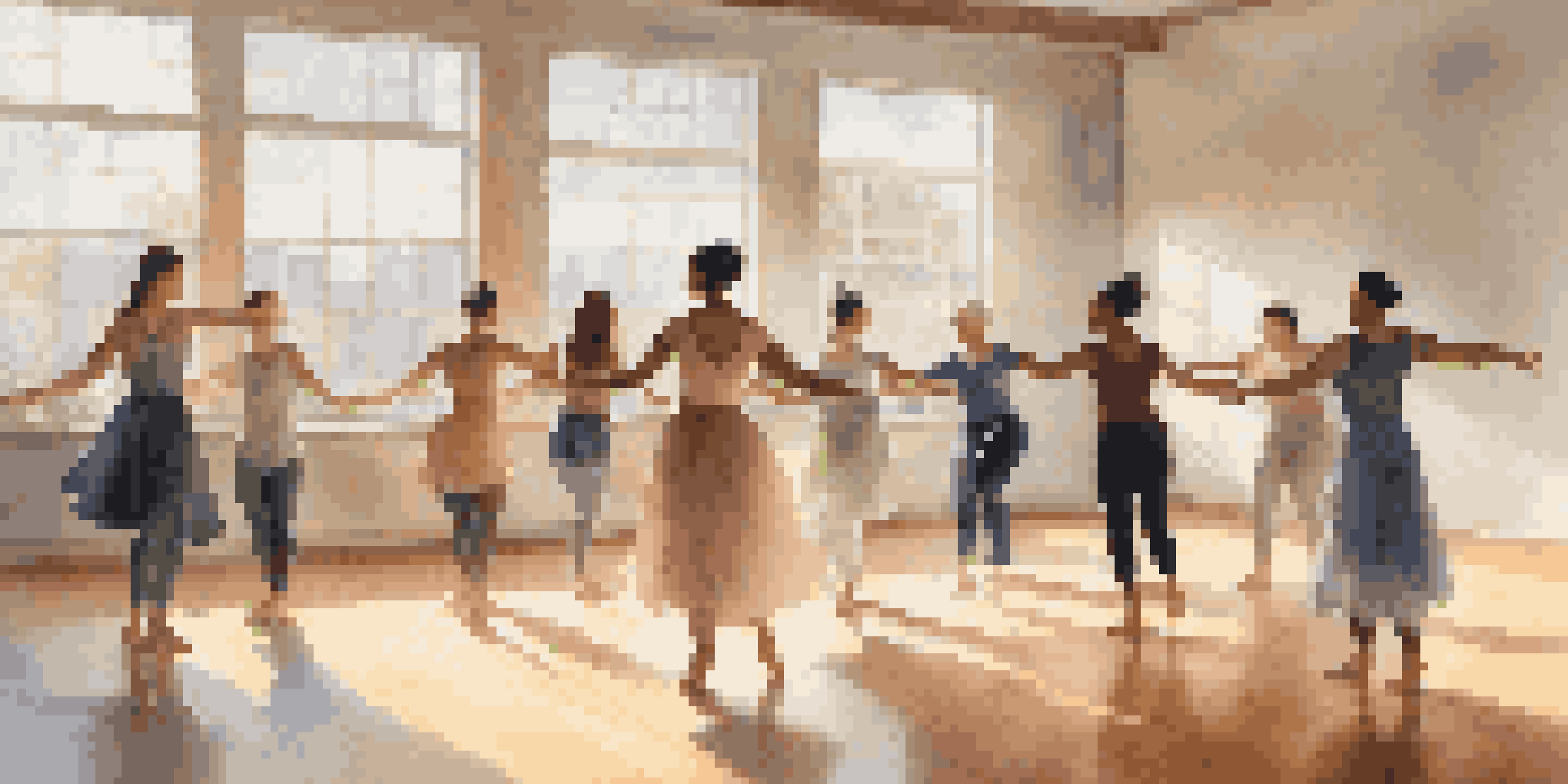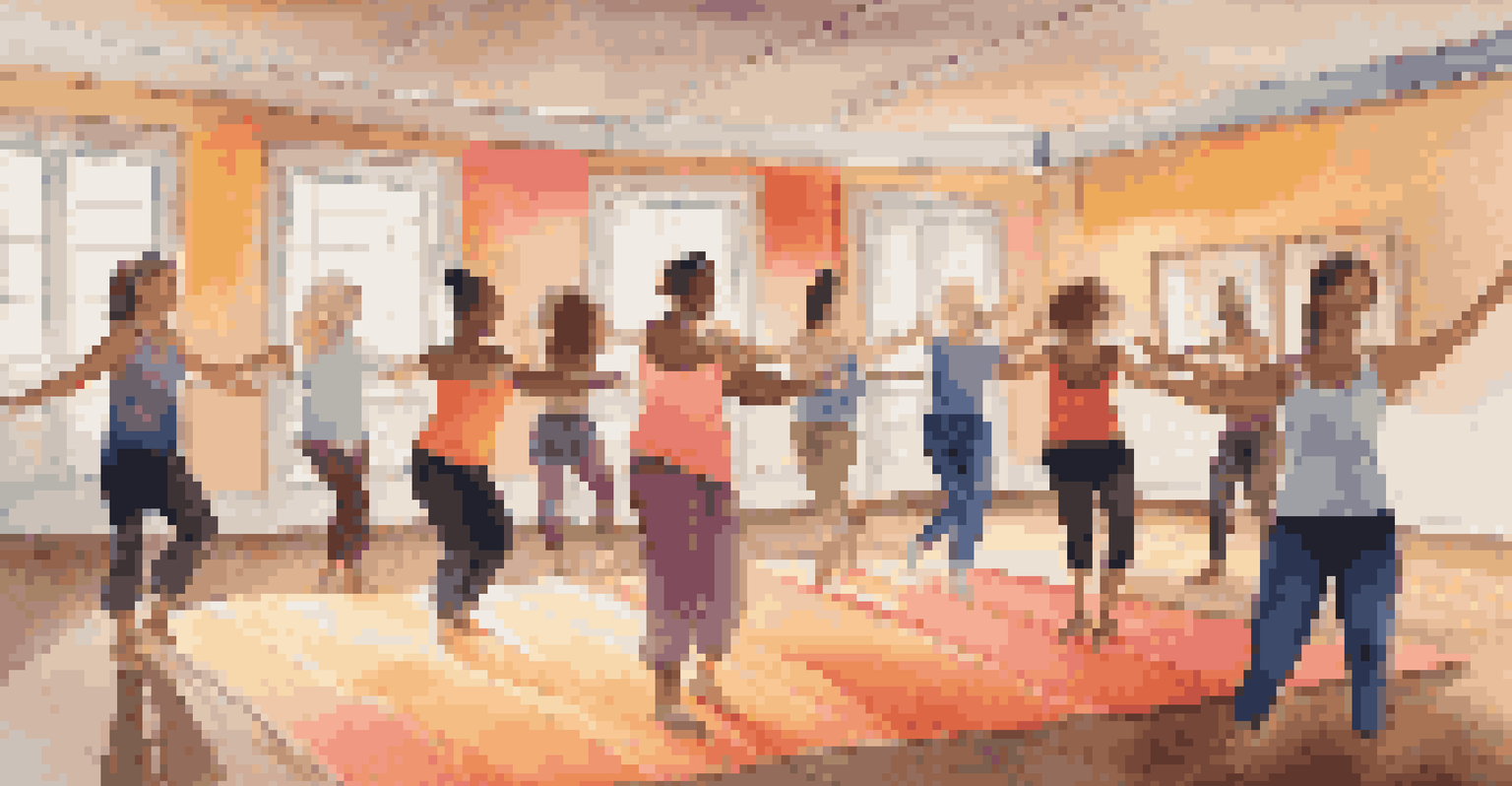Integrating Dance into Mental Health Treatment Programs

Understanding the Connection Between Dance and Mental Health
Dance is not just an art form; it’s a powerful medium for emotional expression. Studies show that movement can significantly impact mental well-being by releasing endorphins, the body's natural mood lifters. This connection helps individuals to process emotions, reduce anxiety, and boost self-esteem, making dance a viable option in mental health treatment programs.
Dance is the hidden language of the soul.
When people dance, they often experience a sense of freedom and joy, which can be particularly therapeutic. This is especially true for those struggling with conditions like depression or PTSD, where feeling trapped in one’s own body can be common. By integrating dance into therapy, practitioners can offer a unique avenue for clients to reconnect with their bodies and emotions.
Moreover, the social aspect of dance fosters community and support, essential components in mental health recovery. Group dance classes or therapy sessions allow individuals to share experiences and build connections, reinforcing the notion that they are not alone in their struggles.
The Science Behind Dance Therapy
Dance therapy, or dance/movement therapy (DMT), is backed by a growing body of research that highlights its efficacy. Studies reveal that engaging in dance can enhance cognitive functions, reduce stress levels, and improve emotional regulation. This therapeutic approach uses movement to help individuals express feelings and experiences that may be difficult to articulate verbally.

For example, a study conducted with patients suffering from anxiety disorders showed that those participating in dance therapy reported lower anxiety levels compared to those in traditional talk therapies. The rhythmic movements and creative expression allowed them to release pent-up emotions and stress, demonstrating that dance can be a powerful tool in the therapeutic arsenal.
Dance Enhances Mental Well-Being
Movement through dance releases endorphins, helping to reduce anxiety and boost self-esteem.
Furthermore, dance therapy is adaptable to various populations, including children, the elderly, and individuals with disabilities. This flexibility means that almost anyone can benefit from its practices, making it an inclusive option in mental health treatment.
Incorporating Dance into Existing Treatment Programs
Integrating dance into traditional mental health treatment programs does not require abandoning existing methodologies; rather, it enhances them. For instance, a therapist might incorporate dance sessions alongside cognitive-behavioral therapy (CBT) to help clients process emotions more effectively. This combination allows for a balanced approach that addresses both the mind and body.
The body says what words cannot.
Therapists can facilitate structured dance sessions focusing on specific emotional themes, encouraging participants to explore feelings through movement. This can be particularly beneficial in group therapy settings, where shared experiences can foster deeper connections and understanding among participants.
Additionally, training therapists in dance therapy techniques can expand their skill sets, enabling them to create more dynamic and engaging treatment plans. This professional development can lead to improved outcomes for clients, as they gain access to a richer tapestry of therapeutic tools.
Benefits of Dance for Emotional Resilience
One of the standout benefits of dance in mental health treatment is its ability to build emotional resilience. Engaging in dance allows individuals to confront and express their emotions, leading to greater self-awareness and coping strategies. This emotional intelligence is vital for managing stress and improving overall mental health.
Moreover, the physical activity involved in dance can lead to improved mood and energy levels. When individuals engage in regular dance sessions, they often report feeling more motivated and less fatigued, which can be a game-changer for those battling depression or anxiety.
Dance Therapy Supports Emotional Growth
Engaging in dance therapy allows individuals to express complicated emotions and improve emotional regulation.
By fostering a positive relationship with movement, dance helps individuals develop a sense of agency over their bodies and emotions. This empowerment can translate into other areas of life, giving individuals the confidence to tackle challenges both inside and outside the therapy room.
The Role of Music in Dance Therapy
Music is a crucial element in dance therapy, acting as a catalyst for emotional expression and connection. The rhythm and melody can evoke specific feelings, helping participants tap into their emotions more easily. This musical backdrop often encourages movement that feels natural and liberating.
For instance, a therapist might choose uplifting songs to inspire joy and celebration in a session, while more somber music might prompt reflection and deeper emotional exploration. This versatility allows therapists to tailor sessions to the emotional needs of their clients, creating a personalized experience.
Additionally, the act of dancing to music often enhances mood and provides a joyful distraction from daily stressors. This combination of music and movement can create a transformative experience, leaving participants feeling refreshed and rejuvenated.
Challenges and Considerations in Dance Therapy
While integrating dance into mental health treatment has numerous benefits, it does come with challenges. Not everyone may feel comfortable expressing themselves through movement, particularly those who have experienced trauma. Therefore, creating a safe and supportive environment is essential for the success of dance therapy.
Therapists must also be mindful of the physical abilities and limitations of their clients. Dance should be inclusive and adaptable, ensuring that all participants can engage without feeling overwhelmed or excluded. This may require additional training for therapists to effectively accommodate diverse needs.
Music Amplifies Dance's Therapeutic Effects
The use of music in dance therapy encourages emotional expression and enhances the overall therapeutic experience.
Lastly, it’s important to measure the effectiveness of dance therapy within treatment programs. Gathering feedback from participants can help refine techniques and improve outcomes, ensuring that dance remains a valuable tool in mental health care.
Future of Dance in Mental Health Treatment
The future of integrating dance into mental health treatment looks promising as awareness of its benefits continues to grow. More mental health professionals are recognizing the importance of holistic approaches that address both the mind and body. This shift could lead to increased funding and support for dance therapy programs in various settings.
Additionally, as research continues to validate the effectiveness of dance therapy, it may become a mainstream option in mental health treatment. This could open up avenues for training programs specifically focused on dance therapy, ensuring more practitioners are equipped to integrate this approach into their work.

Ultimately, as society increasingly values mental health, the incorporation of creative therapies like dance can play a significant role in promoting well-being. By embracing the rhythm of movement, we can create a more dynamic and effective landscape for mental health treatment.